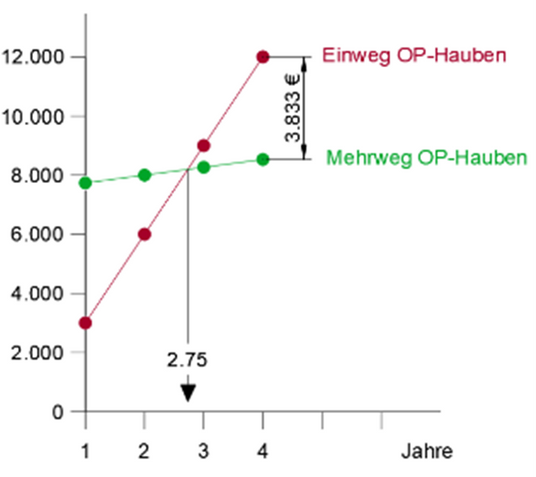Table of contents
- 1.
Introduction
- 2. Disposable vs. reusable surgical caps: Hygiene considerations
- 3. Disposable vs. reusable surgical caps: Cost-effectiveness
- 4. Disposable vs. reusable surgical caps: Environmental considerations
- 5. Disposable vs. reusable surgical caps: Ergonomic considerations
- 6. Disposable vs. reusable surgical caps: A question of safety
- 7. Innovative solutions for clinical environments
- 8. How can you switch to fabric surgical caps?
- 9. Conclusion
- 1. Introduction
- 2. Disposable vs. reusable surgical caps: Hygiene considerations
- 3. Disposable vs. reusable surgical caps: Cost-effectiveness
- 4. Disposable vs. reusable surgical caps: Environmental considerations
- 5. Disposable vs. reusable surgical caps: Ergonomic considerations
- 6. Disposable vs. reusable surgical caps: A question of safety
- 7. Innovative solutions for clinical environments
- 8. How can you switch to fabric surgical caps?
- 9. Conclusion
Introduction
Many hospitals are currently asking themselves whether a switch to reusable fabric surgical caps within the facility is sensible or feasible. To explore this question, this article examines the current scientific evidence on reusable versus disposable surgical caps – evaluated based on hygienic, economic, ecological, and ergonomic criteria.
Choosing the right surgical cap is far more than just a matter of procurement. It directly impacts operating room hygiene, hospital logistics cost-efficiency, sustainability reporting, as well as the well-being and safety of the OR staff.
In a time when hospitals face increasing financial pressure while sustainability goals and employee retention gain importance, a well-founded look at reusable fabric surgical caps is worthwhile.
Procurement professionals in healthcare will gain a solid decision-making foundation from this article, based on current studies, to assess whether and how a switch to modern reusable surgical caps can be sensibly, safely, and economically implemented – tailored to the individual hospital’s needs.
2. Disposable vs. Reusable Surgical Caps: A Hygienic Perspective
Which Surgical Caps Are Hygienic?
Fabric surgical caps are just as hygienic as disposable surgical caps when properly reprocessed. Studies have shown no significant difference in SSI rates (Surgical Site Infection Rate) between fabric and disposable surgical caps.
Surgical Site Infections (SSIs) are infections that occur at the surgical site within 30 days post-operation. SSIs are among the most common therapy-related infections and result in longer hospital stays, additional surgical interventions, ICU treatments, and higher mortality rates. In the years 2021–2022, 10,193 SSIs were reported among 662,309 recorded procedures, corresponding to an infection rate of 1.54%.
https://www.ecdc.europa.eu/sites/default/files/documents/AER-HAI-2021-2022.pdfSurgical site infections occur in 0.6–9.6% of cases depending on the type of procedure and serve as a reliable indicator of cross-contamination during surgery.
When SSI frequencies are analyzed separately for disposable and reusable surgical caps, a meta-analysis by the Healthcare Infection Society (HIS) concludes that there is no significant difference in SSI rates between disposable and reusable surgical caps. The SSI rate was 4.78% for fabric caps and 4.59% for disposable ones, indicating no statistically significant difference.

Furthermore, a sub-analysis of clinics that implemented a comprehensive switch to reusable caps showed no increase in SSI rates.
https://www.journalofhospitalinfection.com/article/S0195-6701(24)00287-1/fulltextTherefore, from a hygienic standpoint, there is no reason to treat fabric surgical caps more restrictively than disposable models, as long as the reusable versions are reprocessed, worn, and changed according to the manufacturer's specifications.
3. Disposable vs. Reusable Surgical Caps: Cost-Effectiveness
Which Surgical Caps Are Economical?
Fabric surgical caps require a higher initial investment than disposable caps but often reach the break-even point during their service life. This makes fabric caps more cost-effective in the long term.
Disposable surgical caps are typical "use and forget" items in the OR. While their unit cost is low, the annual cumulative volume is enormous: An estimate for NHS Scotland reports around 2.46 million disposable caps purchased annually for a total of 394 operating rooms.
According to calculations, investment benefits from reusable surgical caps are already evident in the first year of use. The following assumptions were made:
- - Each staff member is provided with 5 reusable surgical caps
- - Number of ORs: 394
- - Staff size: 3,152
- - Cost of disposable cap: £0.06/unit
- - Cost of reusable cap: £5.99/unit
- - Staff turnover: 13% per year
- - Service life of fabric cap: 3 years
This resulted in savings of £325,112.32 over 3 years.
The meta-analysis by the Healthcare Infection Society (HIS) revealed remarkable results: Reusable surgical caps reach the break-even point depending on wash frequency within 15–26 weeks, with cost savings increasing over time and with longer lifespan.
https://www.journalofhospitalinfection.com/article/S0195-6701%2824%2900287-1/fulltextThe break-even point—the point at which the purchase of reusable surgical caps pays off compared to disposable ones—depends on the acquisition costs, reprocessing costs, and usage needs. Below, we provide purchasers with a calculation framework to determine the break-even point individually.
In our example, we consider a hospital with approximately 30 operating rooms that purchases 1,200 reusable caps, equipping each OR staff member with 5 fabric caps.
| Input Parameter | Value |
|---|---|
| OR Staff Size | 240 people |
| Working Days per Year | 250 working days |
| Cost of Disposable Cap | €0.05 / unit |
| Cost of Reusable Cap | €6.00 / unit |
| Reprocessing Cost per Wash (incl. drying, in-house) | €0.98 |
| Washing Machine Acquisition Cost | €499 |
| Break-Even Point: | 2.75 years |

No exemplo de cálculo, o aumento do investimento inicial em toucas cirúrgicas reutilizáveis compensa-se após aproximadamente 2,75 anos. No quarto ano de utilização, já tinham sido poupados €3.833,00.
As toucas cirúrgicas reutilizáveis requerem um investimento inicial mais elevado, mas este é recuperado num curto espaço de tempo e conduz a poupanças anuais substanciais posteriormente. Para hospitais que já utilizam processamento têxtil central ou têm acesso a lavandarias externas, a introdução de toucas cirúrgicas reutilizáveis é, portanto, extremamente atraente do ponto de vista económico – uma conclusão que também é confirmada por projetos reais de conversão, como o do Hospital Regional de Randers na Dinamarca:
https://randersidag.dk/regionshospitalet-randers-vil-indfoere-genanvendelige-operationshuer/
4. Disposable vs. Reusable Surgical Caps: Environmental Aspects
Which Surgical Caps Are Sustainable?
Studies show that fabric surgical caps have significantly lower environmental impacts than disposable caps in life cycle assessment (LCA) analyses.
Globally, healthcare is responsible for 4–10% of total greenhouse gas emissions. Operating rooms are particularly large resource consumers, contributing 20–30% of hospital waste. This is largely due to the high volume of single-use products.
Switching from disposable to reusable surgical caps is especially relevant from an environmental perspective because caps are small individual items used in very high volumes. The Healthcare Infection Society (HIS) evaluated all available life cycle assessments (LCAs) of surgical caps in their review (J Hosp Infect 152, 2024), incorporating two recent primary studies – Cohen 2023 (JAMA Surgery) and Donahue 2024 (J Surg Res). Both quantify key environmental indicators with concrete figures, allowing the ecological benefits of reusable caps to be precisely measured.
https://www.journalofhospitalinfection.com/article/S0195-6701%2824%2900287-1/fulltextLower impact across all 17 categories examined: Fabric surgical caps performed significantly better in terms of carbon footprint, ozone depletion, fossil fuel use, acidification, and particulate matter formation (all p-values < 0.005 [high statistical significance]). Only in water consumption do fabric caps rank lower than disposable ones, due to the water required for cotton production.
| Environmental Indicator | Disposable Surgical Caps | Reusable Surgical Caps | Unit | Source |
|---|---|---|---|---|
| CO₂ Footprint | 49 kg CO₂ equivalent | 10 kg CO₂ equivalent | Life cycle per cap | Cohen 2023 |
| Water Consumption | 12.66 L | 67.56 L | Life cycle per cap | Donahue 2024 |
| Ozone Depletion Potential | Higher | Lower | Per cap | HIS 2024 |
| Fossil Fuel Use | Higher | Lower | Per cap | HIS 2024 |
| Particulate Matter Formation | Higher | Lower | Per cap | HIS 2024 |
https://www.journalofhospitalinfection.com/article/S0195-6701%2824%2900287-1/fulltext
Across all published environmental impact categories, reusable surgical caps are clearly superior ecologically. After just a few wash cycles, they offset the resource and energy input and then begin saving CO₂, primary energy, and waste. For institutions that already operate a central textile reprocessing facility, the switch is not only climate-friendly but also eliminates significant amounts of single-use plastic waste.
If you would like to learn how Dutch anesthesiologist Niek Sperna Weiland reduced the need for 100,000 disposable surgical caps to just 500 reusable ones per year, you can read his story here: https://www.dutchhealthhub.nl/artikelen/van-wegwerp-naar-hergebruik-op-de-ok
5. Disposable vs. Reusable Surgical Caps: Ergonomic Considerations
Which Surgical Caps Are Ergonomic?
Fabric surgical caps are comparable in weight and fiber composition to lightweight casual wear and offer a comfortable long-term wearing experience.
Surgical caps are worn for 6–12 hours a day. Pressure points, heat buildup, or itching can directly affect concentration, error rates, and ultimately patient safety. Ergonomic quality is primarily measured in terms of skin compatibility, thermal management, fit, and acoustic comfort.
Disposable surgical caps are often made of polypropylene, with a latex elastic band. Both materials can act as allergens and may cause skin irritation. Reusable surgical caps are typically made from cotton, a hypoallergenic natural fiber. Some models may also include polyester, which can rarely trigger allergic reactions.
Cotton is breathable and vapor-permeable, absorbs sweat, and cools as it evaporates.
Polypropylene, on the other hand, is hydrophobic (water-repellent). Sweat beads off, remains on the scalp, and can promote heat stress.
Studies on textile thermal behavior confirm the lower heat dissipation of hydrophobic synthetic fibers compared to natural fibers.
https://pubmed.ncbi.nlm.nih.gov/10602627/Fabric caps are generally tied at the back, eliminating the rigid elastic band that wraps around the head in disposable caps, which can cause compression headaches.
The cotton fabric of reusable surgical caps fits securely, is generally perceived as comfortable, and is comparable in weight and fiber composition to lightweight casual wear. This preference aligns with thousands of verified shop reviews, many of which specifically mention the "comfortable fit" of fabric surgical caps.
From an ergonomic perspective, fabric surgical caps offer clear advantages: fewer skin-damaging reactions, better thermal regulation, and greater long-term comfort. These factors not only enhance staff well-being but also indirectly support concentration and thereby patient safety.
Barnsley Hospital in England has introduced fabric surgical caps embroidered with the wearer’s name and role. This initiative improved staff communication and wearing comfort. Additionally, the hospital's switch to reusable garments reduced CO₂ emissions by 66% and waste by 83%.
https://www.barnsleyhospital.nhs.uk/news/eco-friendly-surgical-caps-and-gowns-benefit-patients-staff-and-environment6. Disposable vs. Reusable Surgical Caps: A Matter of Safety
What Do Surgical Caps Protect Against?
Surgical caps protect against contamination of the surgical field. As part of personal protective equipment (PPE), high-quality fabric surgical caps offer users a basic level of physical protection against minor mechanical impacts.
The safety of operating room staff is a fundamental requirement in everyday medical practice. The final report “Safety and Health in the Operating Room” from the Berlin Accident Insurance Fund (Unfallkasse Berlin) from November 2004 analyzed 500 accidents involving insured personnel working in the OR.

https://sikh.rms2cdn.de/files/docs/op/SIGOS.pdf
The most common types of accidents include pierce and cut injuries, pinching, and bumping incidents.
Reusable surgical caps, due to their more robust materials, can offer a degree of protection against minor, superficial mechanical injuries. At the same time, the ergonomic advantages of reusable caps have a positive impact on the user’s concentration, which can help reduce the risk of accidents. In terms of head-related workplace safety incidents in the OR, reusable surgical caps provide a clear advantage over disposable products.
7. Innovative Solutions for Clinical Environments
It has been shown that reusable surgical caps are hygienically equivalent, more economical in the long term, environmentally beneficial, and ergonomically superior compared to disposable products. For forward-thinking purchasers and practice managers, the question is no longer "if," but rather "when" and "how" to make the switch to reusable surgical caps.
Numerous suppliers of fabric surgical caps are available both domestically and internationally, but significant differences in quality may exist. For this reason, MEDONiS GmbH has developed a reusable surgical cap that combines all the advantages in a single product and more than meets the hygiene standards of the healthcare sector.
The Bandana Comfort-Pro surgical cap, certified as Category I Personal Protective Equipment (CE), combines comfort, user safety, hygiene, and sustainability. Suitable for industrial reprocessing, wrinkle-resistant, and optionally equipped with an RFID chip, this surgical cap—made from OEKO-TEX certified materials—is a must-have for every modern OR team.
Of course, the Bandana Comfort-Pro surgical cap can also be embroidered with a company logo to strengthen the organization’s brand identity.
8. How to Transition to Fabric Surgical Caps
Introducing new products and establishing new processes is often associated with many hurdles. That’s why we’d like to provide you with a rough guideline to help you develop a solid concept for implementing reusable surgical caps. Since processes vary greatly between institutions, only key points and a basic workflow are outlined here.
- Needs and Cost-Benefit Analysis
- - Determine current annual consumption of disposable surgical caps
- - Identify the break-even point including wash/sterilization cycles of fabric caps
- Product Specification and Procurement
- - PPE Category I / CE marking, sterilizability at 121 °C / 20 min, OEKO-TEX, protective function, high wash temperatures, sizes, colors
- - Is embroidery with the clinic logo desired?
- - Obtain offers for reusable caps and compare quality/pricing
- Reprocessing Organization
- - What cleaning procedures are used? Is there infrastructure for in-house reprocessing? Are there contracts with commercial laundries? Is regular sterilization planned, e.g., every 10 wash cycles?
- - Draft a validation plan and define reprocessing steps
- - Clear/dirty segregation: provide separate containers for staff
- RFID Tracking
- - Reusable caps can be equipped with RFID chips (e.g., sewn into the inner ties) to enable complete tracking of usage cycles.
- Distribution and Logistics Within the Team
- - Define demand per OR or OR team (e.g., team size × 1.3)
- - Dispensing lockers or a central issue point near the changing area
- - Labeled return containers, optionally with RFID scanning
- Quality Assurance
- - Visual inspection of caps after each reprocessing cycle
- - Occasional microbial load tests?
- - Optionally, quarterly audits: track number of cycles vs. functional integrity, document loss rate
- - Collect feedback from staff comparing disposable vs. reusable caps
- Legal Documentation
- - Evidence for authorities: document CE certificates and validation data
- - Integrate measures into sustainability reports, waste balances, etc.
9. Conclusion
Fabric Surgical Caps Offer Clear Advantages Over Disposable Ones
Reusable fabric surgical caps are hygienically equivalent, more economical in the long term, more environmentally friendly, and excel in wearing comfort and skin compatibility.
Clinical studies show no increase in infection rates—but do show measurable reductions in waste, CO₂ emissions, and costs. At the same time, OR teams benefit from a better fit, fewer pressure points, and a more pleasant microclimate. The option for personalization improves internal communication and strengthens team identity.
Those in hospital leadership who act now send a clear signal for quality, sustainability, and economic thinking—without compromising on safety. The #1 choice in reusable surgical caps: Bandana Comfort-Pro – Request a quote now!


